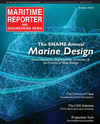
Page 54: of Maritime Reporter Magazine (October 2018)
Marine Design Annual
Read this page in Pdf, Flash or Html5 edition of October 2018 Maritime Reporter Magazine
“When auto emissions were ? rst put into place, the auto guys said they couldn’t do it. But they have met or exceeded those standards. If there is a rule out there that needs to be done, the shipping industry will require some way of meeting it even if we may not understand [what it will be] today. Markets will balance.”
Rick Ashcroft, functional vice president technology and Chair of the the Tech- nology & Research Steering Committee at the SNAME isn’t much reason to believe that slow There are all these things you have to It can be captured and even recycled as steaming is as common as is claimed,” think of.”’ a form of energy, but it’s complicated, says Harvey, adding that the practice is costly and still being looked at. hard to track and enforce. “There is very Refueling infrastructure is a signi? cant little transparency in the industry and barrier to LNG, says SNAME’s Barry. “LNG can provide marginal improve- few real incentives for the crew to slow Depending on where a vessel’s sched- ments on carbon as compared to HFO, down. It’s more likely that the incentives ule take it, it could be dif? cult to ? nd a but those improvements are reduced promote faster speeds,” he says, add- refueling source, which means a vessel dramatically when accounting for the ing that speed is driven by economics, might need to make room on board to impact of upstream methane emis- not corporate social responsibility. carry enough fuel to support a roundtrip. sions,” says Harvey, adding that meth-
Ashcroft points out that hulls are opti- (Actually, refueling and recharging are ane emissions are signi? cantly worse mized for speci? c speeds, and not for issues for multiple low- or zero emission for the climate than burning diesel, HFO slow speeds, which could minimize any fuel sources.) or coal. He thinks investors, owners and bene? ts from slow steaming attempts. operators need to be concerned about
Hybrid solutions that use LNG and making big ? nancial commitments to diesel create another worry for own- LNG and its bunkering infrastructure.
CATCH THE LNG WAVE ers and operators who have expressed For one, associated policy changes
Less energy-dense LNG requires refrig- concern about safety issues and engine “could easily strand all that investment.” eration (which requires its own energy), failures, should fuels be mixed or crews And advances in hydrogen fuels could lots of storage in new types of tanks, dif- not receive training for LNG. “There make it competitive with LNG long be- ferent tank placement etc., all of which have been incidents during switchover fore LNG investments are paid off.
can pull the ship off center and cut into when ships have lost power, but they do container space if not carefully posi- restart,” agrees Ashcroft.
SCRUBBERS tioned. “If you have to maintain a spe- One signi? cant drawback to LNG is an ci? c speed to remain competitive, can emission of a different kind that must Another option in play today are “scrub- you afford a 10% reduction in power?,” be contained – poisonous methane gas bers,” which remove pollutants from posits Barry. “Nothing is free; everything - which is said to be even more detri- smokestacks. In recent weeks, the is a tradeoff in the engineering world. mental to the environment than carbon. number of companies planning to install
Source: Rocky Mountain Institute-Carbon War Room
Maritime Reporter & Engineering News, October 2018 th
SNAME 125 Anniversary Special 54
MR #10 (50-57).indd 54 MR #10 (50-57).indd 54 10/5/2018 10:44:12 AM10/5/2018 10:44:12 AM

 53
53

 55
55
